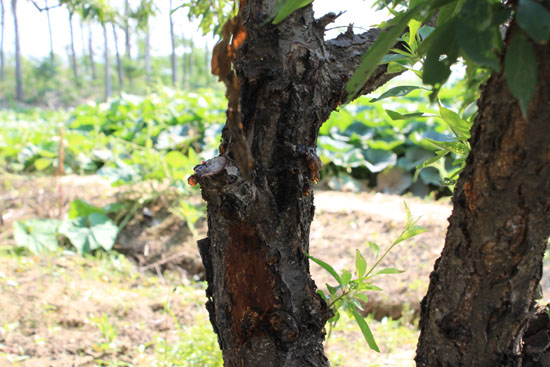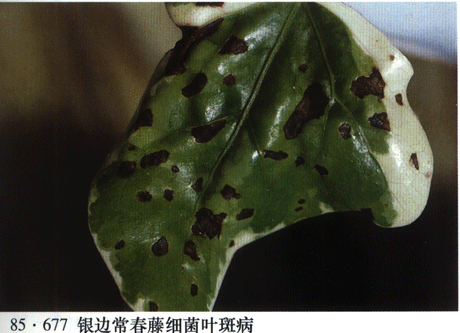Anthracnose of camellia
The symptoms and pathological changes were mainly harmful to the leaves. On the diseased leaves, there are round or irregularly shaped brown to grayish brown disease spots, the edges are dark or yellow halo, some of the disease spots are gray-white, leaf spots are sunken or have dark edges.
Small black spots are streaked or scattered on the disease spot. Pink gel appeared on the small spots when it was wet, and the diseased leaves were easy to fall off, and in severe cases, only a few leaves remained in the whole plant; light brown spots appeared on the branches, then gradually withered, grayish white, with black spots, and in severe cases, the disease spots spread downward and withered the branches.
The pathogen of the disease is fungus, which overwinters on diseased leaves and branches. Under suitable conditions, the newly produced and overwintered conidia are transmitted by wind, rain and insects, and invade into the epidermis by injured □, stomata or directly. There is a habit of latent invasion after invasion, and disease spots appear when the plant is weak or the environmental conditions are favorable for the disease.
Prevention and control methods: 1. Strengthen fertilizer and water management, do a good job in nursery ditching and drainage, prevent soil from being too wet, and enhance plant disease resistance. 2. 2. In winter, combined with pruning to remove diseased branches and leaves, remove fallen leaves and destroy them centrally. 3. Chemical control: it can be sprayed with 500x solution of 25 carbon tetralin wettable powder or 800,1000 times liquid of 50% topiramine wettable powder or 1000 times liquid of 50% carbendazim wettable powder. Spraying 0.3% "0.4%" potassium hydrogen phosphate solution can enhance plant resistance.

The distribution and harm of camellia anthracnose mainly harms leaves and shoots. The symptoms are mainly harmful to leaves and tender shoots. Germs often invade from leaf tips and leaf edges to form round or irregular plaques. Dark brown, the edge is raised, and the spots are of different sizes. Black spots grow on the lesions in the later stage, whorled or scattered. When the humidity is high, it overflows the pink sticky mass. The diseased leaves are dry and easy to fall off. the new shoot disease spot is long. Slightly sunken, light brown, the edge is obvious, and the branches die when it is serious. The pathogen overwintered on the diseased plant and residual body in the form of mycelium or conidia and spread through wind and rain. mostly invaded from the wound and weak part. plant growth is weak and drainage is poor. High temperature and high humidity are conducive to the occurrence of diseases. Control methods: remove dead branches and fallen leaves, cut off diseased branches and destroy them. Add organic fertilizer, phosphorus and potassium fertilizer and ferrous sulfate to enhance disease resistance. spray the new shoots after extraction. Use "50% carbendazim 1000-fold solution, 75% chlorothalonil 1000-fold solution or 80% anthrax Fumei 800-fold solution, once every 10 to 15 days, spraying 45 times continuously.
Anthracnose of Camellia
Shanghai, Zhejiang, Yunnan, Sichuan, Guangdong, Fujian, Jiangsu, Shaanxi and other areas are also serious diseases on Camellia oleifera.
[symptoms] Colletotrichum gloeosporioides mainly attacked the leaves and twigs of camellia. Leaf tip or leaf margin is susceptible to disease, and can also harm twigs and fruits. At the beginning of the disease spot, the leaf spot is light brown, semicircular or irregular, and gradually browns; in the process of the development of the disease spot, the color changes from inside to outside to gray-white, and there are not obvious wheel wrinkles, the edge is purple-brown or dark brown, and the boundary between the disease spot and the healthy part is obvious. In the later stage, the center is gray-white, the edge is dark brown, there are wheel-like wrinkles, the upper whorls or scattered small black spots, the disease spots are of different sizes, and indeed expand to the whole leaf, the diseased leaves are brittle and easy to fall off; the disease spots on the fruit are purple-brown to black, round, and when serious, the whole fruit turns black. The disease spot on the twig is striped, purplish brown, slightly sunken; in severe cases, the branch dies. In a humid environment, red mucus is easy to be seen on the disease spot of the fruit.
[pathogen] the pathogen is fungus, Colletotrichumcamelliae. Half-known subphylum, Coelospora, Coleoptera, Coleophora, Coleoptera. The pathogen was infected and spread by conidia, which were long oval, unicellular and colorless in the conidia disk. The temperature range for the growth and development of the pathogen is 20 Mel 32 degrees Celsius, and the optimum temperature is 27 mi 29 degrees Celsius.
[incidence regularity] the pathogen overwintered on the diseased plant or soil surface in the form of hyphae or conidia. When the temperature is more than 20 ℃ in spring, the bacteria produce spores and spread by wind and rain. Wind and rain, long sunny showers, or hot sun after rain, invade leaves and shoots through wounds or leaf scars, lenticels and other natural holes. When the tissue is tender. It's easy to get sick. Too much nitrogen fertilizer, or poor soil, weak growth, and easy to get sick. The onset period is from April to November, and the peak period is from June to September. The sticky soil, partial application of nitrogen fertilizer and tender branches and leaves are beneficial to bacterial infection. Too dense planting and poor ventilation are conducive to the spread of the disease. In general, single camellias such as Venus and Mei Ren tea have strong disease resistance, while double camellias such as Eighteen Scholars and Chang'e powder have poor disease resistance.
[prevention and control methods]
(1) Horticultural control: removing diseased branches and diseased bodies in combination with pruning in autumn and winter; picking diseased leaves in time in spring. When watering, it should be poured from the edge of the basin, not sprayed; acid mud should be used as cultivation soil to reduce artificial and sunburn wounds. Increasing the application of organic fish fertilizer and phosphorus and potassium fertilizer can improve the disease resistance of plants.
(2) Chemical control: 1% Bordeaux solution was sprayed when the new shoots were extracted to prevent the first infection. During the onset of the disease, 65% Daimen zinc 600 murine 800 times or 70% anthrax Fumei 500 times, or 70% mancozeb 800 times, or 75% chlorothalonil 700 times, or 50% carbendazim 500 times, for many times in a row.
- Prev

Green peach gummy disease
Symptoms and pathological changes: the disease occurred in branches, bark lenticels and injured □, cracks □ and other places, the initial part of the disease slightly expanded, brown, and then the flow of translucent milky white soft colloid, the phenomenon of glue flow was more serious after rain. The gel becomes sticky in the presence of air, yellowish brown, and becomes a hard lake-shaped glue when dry.
- Next

Ivy leaf spot
Symptoms and pathological changes: in the early stage of the disease, there were small round dark spots on the leaf surface with oily halo. After the expansion, it is black. Some become polygonal, sometimes there are brown deposits around the spot, and occasionally ulcer spots occur on the petiole. The infected leaves do not fall off. The disease overwinters in the diseased tissue.
Related
- Fuxing push coffee new agricultural production and marketing class: lack of small-scale processing plants
- Jujube rice field leisure farm deep ploughing Yilan for five years to create a space for organic food and play
- Nongyu Farm-A trial of organic papaya for brave women with advanced technology
- Four points for attention in the prevention and control of diseases and insect pests of edible fungi
- How to add nutrient solution to Edible Fungi
- Is there any good way to control edible fungus mites?
- Open Inoculation Technology of Edible Fungi
- Is there any clever way to use fertilizer for edible fungus in winter?
- What agents are used to kill the pathogens of edible fungi in the mushroom shed?
- Rapid drying of Edible Fungi

